OLSAT 8 Grade 2 Level C Online Test Preparation
Visuprep provides OLSAT 8 test prep software to help prepare for the OLSAT 8® Level C Grade 2 tests (taken by 2nd graders). Visuprep has 4 OLSAT tests, and each OLSAT prep test costs $20 for one year’s membership, and contains 60 questions. All 4 OLSAT tests can be purchased for a reduced price of $60. To help with test preparation and practice for grade 2 OLSAT tests, each prep test comes with explanations for (in addition to answers to) the test questions.
Video Explanations of some OLSAT Questions
Visuprep’s OLSAT software contains written explanations for the questions.
Below, we have provided videos (in English and Spanish) on how to solve an OLSAT Aural Reasoning and an OLSAT Pattern Matrix question.
English Version
Spanish Version
Visuprep OLSAT Level C (Grade 2) Demo
Note that you can expand (enlarge) the size of the text and images in the OLSAT prep test demo software on a mobile or tablet by using pinch-to-zoom. Pinch-to-zoom is when you place your thumb and a finger close together on the screen and move them apart without lifting them from the screen. To reduce the size of the text and images in the OLSAT prep test demo software, place your thumb and a finger a little distance apart on the screen and move them toward each other without lifting them from the screen.
Click on the links below to run the OLSAT prep test demos.
The untimed test has answers immediately after each question, the timed test has answers at the end of the test.
OLSAT Level C 2nd Grade Demo (Untimed)
OLSAT Level C Grade 2 Demo (Timed)
A pdf file of the sample questions in the OLSAT prep test demo, together with the answers, is available by clicking on the link below:
Format of the OLSAT Grade 2 Level C Test
The OLSAT Level C Grade 2 test is a 60 question, 60 minute test (excluding the time needed to answer the sample questions). The test contains verbal and nonverbal question categories.
For the OLSAT Level C 2nd Grade test, the verbal category of questions is made up of verbal comprehension and verbal reasoning subcategories and the nonverbal category of questions is made up of pictorial reasoning and figural reasoning subcategories. Each of these subcategories is divided into further subcategories as listed below:
Total Number of Questions: 60
(Number of Verbal Questions: 30, Number of Nonverbal Questions: 30)
Question Types For Each Verbal Question Category:
Verbal Comprehension
- Following Directions – 10 Questions
Verbal Reasoning
- Aural Reasoning – 10 Questions
- Arithmetic Reasoning – 10 Questions
Question Types For Each Nonverbal Question Category:
Pictorial Reasoning
- Picture Classification – 5 Questions
- Picture Analogies – 5 Questions
Figural Reasoning
- Figural Classification – 5 Questions
- Figural Analogies – 5 Questions
- Pattern Matrix – 5 Questions
- Figural Series – 5 Questions
Examples of the question types are shown in the demos and the pictures below.
The sample questions that appear in our demo software are shown below.
Choose the answer that shows a porcupine.
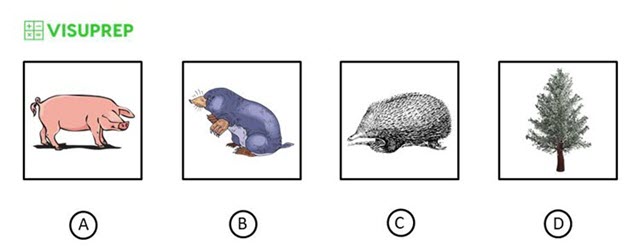

A chef gave instructions on how to set a table as shown in the leftmost picture below. Mike tried to follow the chef’s instructions but made some mistakes when setting the table. To fix his mistakes, Mike needed to switch two objects and move another object. Which one of the four pictures on the right shows how Mike set the table before he fixed it?


Looking at picture (B), switching the fork and the spoon, and then moving the bread to the right gives the same table setting as the chef’s setting (which is the leftmost picture). Therefore (B) must be the way Mike set the table before fixing it.
Note that the answer cannot be (A), because to get to the chef’s setting from picture (A), all that is needed is to switch the fork and the spoon i.e. there is no movement of another object required.
The answer cannot be (C), because to get to the chef’s setting from picture (C) requires switching the wine and the bread and switching the fork and the spoon i.e. it requires two switches rather than one switch and one movement of another object.
The answer cannot be (D), because to get to the chef’s setting from picture (D) requires two movements of objects i.e. moving the wine to the left and moving the bread to the right, and it requires switching the knife and the spoon, so it requires one switch and two movements of objects rather than one switch and one movement of objects.
Count how many apples are in the first picture. If 2 children take 3 apples each, how many apples would be left?


There are 8 apples in the first picture. If 2 children take 3 apples each, then altogether the 2 children take 6 apples. Thertefore the number of apples left will be 8 – 6 i.e. 2 apples.
Four of these pictures have something in common. Choose the picture that is not like the others.


(D) is rhubarb, which is a vegetable. The other four (i.e. pears, a cucumber, a tangerine and plums) are all fruits.
The pictures on the top row are related. Which answer should go in the box containing a question mark so that the pictures on the bottom row are related in the same way as the pictures on the top row?
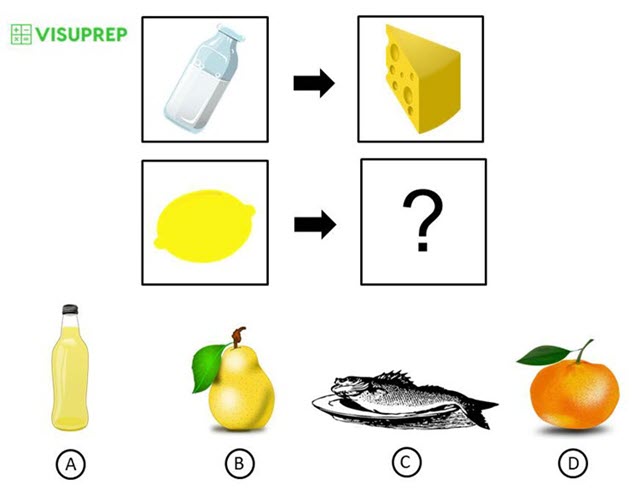

The relationship between the pictures on the top row is that cheese is made from milk. The answer will be something that is made from a lemon or lemons. Therefore the answer is (A), lemonade.
Choose the figure which is not like the others.


The answer is (E) because, unlike the other four figures, the red rhombus is not in a triangle by itself and because, unlike the other four figures, the light blue triangle and the yellow cross are not within the same triangle.
The figures on the top row are related. Which answer should go in the box containing a question mark so that the figures on the bottom row are related in the same way as the figures on the top row?
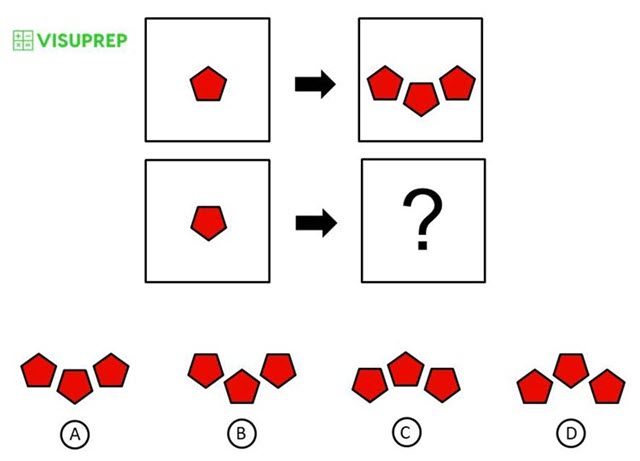

Looking at the figures on the top row, the box on the left has a pentagon pointing upward, and the box on the right has the same pentagon pointing upward on the left and right end, and has a pentagon pointing in the opposite direction (i.e. downward) in between them. Also, the middle figure (i.e. the pentagon pointing downward) is positioned lower than the left and right figures (i.e. the two pentagons pointing upward).
Then, looking at the bottom row, the figure in the box on the left is a pentagon pointing downward. Therefore the box on the right will contain three pentagons – a pentagon pointing downward on the left and right and a pentagon pointing in the opposite direction (i.e. upward) in between them, and the pentagon pointing upward will be positioned lower than the two pentagons pointing downward. Therefore the answer is (B).
In the matrix below, there are several shapes that go together in a certain way. Choose the figure that goes in the box containing the question mark.
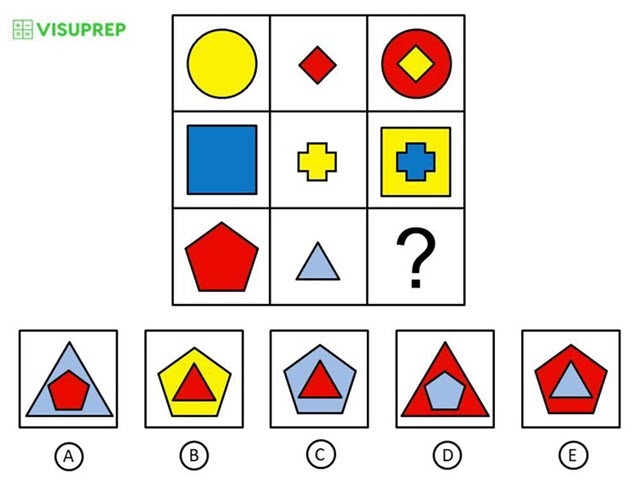

Looking at each row, the figure in the third box is the result of combining the shape in the first box with the shape in the second box and switching the colors of the shape in the first box and the shape in the second box.
Therefore the answer is the combination of the red pentagon and the blue triangle with their colors switched, resulting in a combination of a blue pentagon and a red triangle i.e. answer (C).
Choose the figure that continues the series and goes in the box containing a question mark.
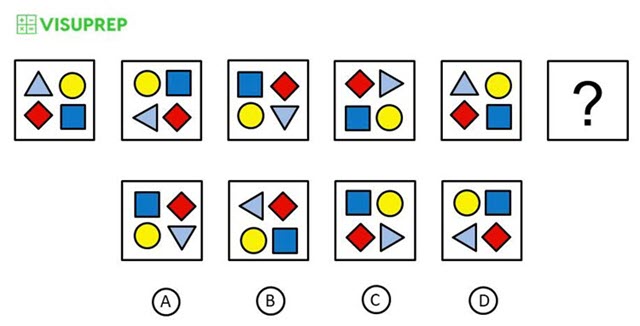

Each figure in the series, apart from the first figure, is the previous figure rotated 90 degrees anticlockwise. Therefore the 6th figure will be the 5th figure rotated 90 degrees anticlockwise, so the answer is (D).
Otis-Lennon School Ability Test® Eighth Edition and OLSAT 8® are registered trademarks of Pearson Education Inc. or its affiliate(s), or their licensors. Visuteach and its website, visuprep.com, are not affiliated with nor authorized, sponsored or otherwise approved by Pearson Education Inc. or its affiliates.







